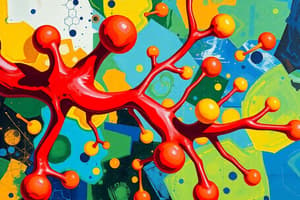Podcast
Questions and Answers
What is the role of α-amylase in carbohydrate digestion?
What is the role of α-amylase in carbohydrate digestion?
To hydrolyze starch into maltose and oligosaccharides.
Where does carbohydrate digestion begin?
Where does carbohydrate digestion begin?
In the oral cavity.
Which of the following are final products of carbohydrate digestion? (Select all that apply)
Which of the following are final products of carbohydrate digestion? (Select all that apply)
- Galactose (correct)
- Maltose
- Glucose (correct)
- Fructose (correct)
Salivary amylase remains active at a pH of 4.0.
Salivary amylase remains active at a pH of 4.0.
What is lactose intolerance caused by?
What is lactose intolerance caused by?
Match glucose transporters with their main characteristics:
Match glucose transporters with their main characteristics:
What is the primary mechanism for glucose transport across the intestinal epithelium?
What is the primary mechanism for glucose transport across the intestinal epithelium?
Phlorhizin is an inhibitor of the __________ and hence of glucose reabsorption in the kidney.
Phlorhizin is an inhibitor of the __________ and hence of glucose reabsorption in the kidney.
Which of the following facilitate transport of fructose? (Select all that apply)
Which of the following facilitate transport of fructose? (Select all that apply)
What happens to glucose in pancreatic beta cells?
What happens to glucose in pancreatic beta cells?
Flashcards are hidden until you start studying
Study Notes
Digestion of Carbohydrates (CHO)
- Digestion begins in the oral cavity with saliva containing α-amylase, which hydrolyzes starch into maltose and oligosaccharides.
- Salivary amylase becomes inactive at pH 4.0.
- In the small intestine, pancreatic amylase further breaks down carbohydrates into maltose, glucose, and isomaltose (two glucose molecules linked by 1-6 connection).
- Intestinal disaccharidases (maltase, sucrase, lactase, isomaltase) complete carbohydrate digestion.
Lactose Intolerance
- Deficiency of lactase enzyme leads to lactose intolerance, causing osmotic diarrhea.
- Over 70% of adults globally suffer from lactose intolerance, with the mechanism behind lactase loss with age still unknown.
Final Products of Carbohydrate Digestion
- Primary end products are glucose, with fructose, galactose, and pentoses also produced.
Absorption of Monosaccharides
- Monosaccharides are absorbed through active transport (against concentration gradient) and facilitative transport (diffusion).
- Glucose and galactose are absorbed actively, requiring:
- Hydroxyl (-OH) group on carbon 2
- Pyranose ring structure
- Methyl group at carbon 5
- Fructose absorption occurs more slowly through active transport.
- Active transport of glucose is powered by the sodium pump, functioning in both small intestine and kidney tubules.
Inhibitors in Glucose Reabsorption
- Phlorhizin inhibits the sodium pump, disrupting glucose reabsorption in the kidney.
Glucose Transporters
- GLUT1: Ubiquitous distribution; essential for basal glucose uptake, particularly in erythrocytes and brain endothelial cells.
- GLUT2: Bidirectional transporter found in the gut, liver, and pancreatic islets; involved in glucose uptake for glycolysis and release during gluconeogenesis.
- GLUT3: Predominantly in neurons and placenta, playing a critical role in glucose transport in the brain.
- GLUT4: Located in insulin-responsive tissues like skeletal muscle, adipose tissue, and heart; critical for glucose uptake post-meal.
- GLUT5: A Na+-independent transporter facilitating fructose absorption alongside glucose and galactose via concentration gradients.
Mechanism of Transport
- SGLT 1 (sodium-glucose transporter) works with Na+-K+ pump to transport glucose and galactose into intestinal mucosal cells against concentration gradients.
- GLUT 5 facilitates the transport of fructose along concentration gradients.
- All monosaccharides exit intestinal cells through GLUT2 into portal circulation.
Studying That Suits You
Use AI to generate personalized quizzes and flashcards to suit your learning preferences.




